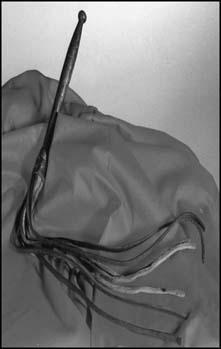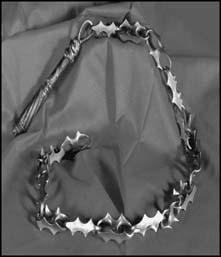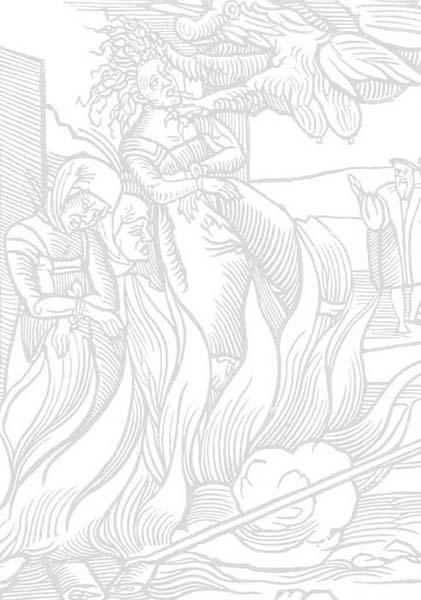The Big Book of Pain: Torture & Punishment Through History (45 page)
Read The Big Book of Pain: Torture & Punishment Through History Online
Authors: Daniel Diehl
Flail.
CHAIN WHIP
Attached to a foot-long handle were three or four lengths of stout chain of the type now thought of as ‘towing chain’. The chain whip probably would not break the skin, but if wielded properly could certainly break ribs, arms and collar bones. This sort of device might be better classed as a weapon than an instrument of torture. It probably finds its inspiration in the military flail, which in turn was inspired by the agricultural threshing flail.

Flail.
JAILER’S WHIP
With a short, stout wooden handle similar to that used on the chain whip, the jailer’s whip was fitted with a single, 8 or 10in length of chain with a 4–6oz cast iron or lead weight on the end. There is little doubt that if properly used it could crush a man’s skull like a ripe melon. As with the chain whip above, the inspiration behind this device can presumably be found in the military weapon of the flail, ball and chain, or morning-star.
BULLET WHIP
This interesting derivation on the standard whip was simplicity itself. Two or three dozen musket balls were sewn into a leather tube and attached either to a wooden handle as described above or to a simple leather strap that could be looped around the user’s wrist. When rolled up it could be concealed in a man’s pocket, but was as effective as a length of chain when put into action.
BRITISH ARMY
Although the British were as quick to flog disobedient soldiers as any other military establishment, it was not until the Mutiny Act of 1689 that flogging became a part of official British military policy. Standard sentence for minor infractions was established at ten lashes and anywhere up to thirty-nine could be administered for more serious transgressions. Naturally, as the whippings did little to eliminate insubordination, the number of prescribed lashes increased. By the early eighteenth century a deserter could be sentenced to as many as 900 lashes and if the desertion took place while the soldier was on guard or sentry duty it could go as high as 1,500. In October 1762, three men were convicted of dereliction of duty and sentenced, respectively to 800, 600 and 300 lashes. When such draconian sentences were imposed an army surgeon was always on hand to see that the man did not die of his wounds. If shock and blood loss became too severe, a temporary halt was called and the man taken to the base hospital where he could recover sufficiently before the remainder of the punishment was carried out. Most military floggings were carried out before the entire assembled company as a drummer beat time to keep the rhythm of the whip steady; the slower the drum beat, the longer the interval between lashes. Even as late as the Napoleonic Wars (1804–15), the Duke of Wellington himself remained convinced that his men were only effective so long as they lived under the threat of the lash. Wellington once remarked of his men: ‘They are the scum of the earth. I have no idea of any great effect being produced on British soldiers by anything but the fear of immediate corporal punishment’. A member of Wellington’s 1st Grenadier Guard regiment, having been convicted of insubordination, drunkenness on duty and refusal to surrender his musket to his superior officer was sentenced to 500 lashes. During the Peninsular War, carried out against Napoleon’s forces in Spain, a soldier was so seriously flogged for the offence of being dirty during an inspection that he died of his wounds several days later.
As imitators of the British system, the American Colonial Army, under the Command of George Washington, suffered at least as harshly as their British counterparts. American soldiers could be mercilessly flogged for such minor infractions as wearing their hat at the wrong angle, ‘malingering’, swearing, not cleaning their musket properly, and not having their full compliment of ammunition.

Military flogging as punishment for pillaging.
BRITISH NAVY
Throughout much of the seventeenth and eighteenth century the British Navy was made up not of recruits or volunteers, but of ‘impressed’ men. Press gangs wandered the streets and prisons looking for victims who could be ‘recruited’ by being abducted or bludgeoned into unconsciousness only to wake up aboard one of His Majesty’s ships already far from port. Considering the unwillingness of these recruits and the fact that they often had no idea what was expected of a sailor, brutal discipline was the tool of choice for teaching them the ropes – literally. When ordered to climb into the rigging, the last man up, and the last man back down, was often flogged.
For this and other minor infractions, the victim was condemned to ‘Kiss the Gunner’s Daughter’ – that is to be bent across the barrel of a cannon while he was beaten with a 5ft length of rope, as thick as a man’s wrist, that had been coated with tar.

Cat-o-ni ne tails.
CAT-O-NINE TAILS
Notorious among whips was the ‘cat-o-nine tails’, commonly used by the Royal Navy for formal punishments of all types. The condemned man was tied, spread-eagle, to an up-ended grating, lifted from one of the ship’s hatches, while officers and crew assembled on the main deck to witness the punishment. The punishment was usually administered by the Sergeant of Marines or, if there were no marines aboard, by the boatswain’s mate. It is worth noting that the cat could only be used on the open space of the main deck; the confined quarters and low ceilings of the lower decks allowed ‘no room to swing a cat’ – the origin of the common expression alluding to confined spaces. The ‘cat’ itself was a nine-thonged whip; each thong being about 2½ft in length and having two or three knots along the length of the thong. The nine braided tails cut through the skin and the knots ripped out pieces of flesh with each lash. After each lash, the punishment officer paused long enough to untangle the ‘tails’, lean back to apply the full force of his body to the work, take one step forward, sweeping his arm in an arc and bring the whip into contact with the miscreant. It has been said, by those who witnessed such punishment, that the bite of the cat was like having a furious hawk rip pieces of flesh from your back with its talons. The frequency with which this brutal weapon was used is made clear in the records of the Royal Navy. In 1759 alone there were four instances where ‘major’ floggings (more than two dozen lashes) with the cat took place. John Gazard received 600 lashes for insubordination, James Mansfield 400 for stealing, Thomas Golden and Francis French each receiving 350 lashes for desertion and ‘scandalous actions’, respectively.
RUSSIA
Russia may not have been infected with as many variations of the whip as the British or the Romans, but what they did have was the
knout,
introduced in the fifteenth century by Ivan III.
KNOUT
The knout was a one-handed whip like the cat-o-nine tails, but its three or four 2ft-long thongs were made from stiff, twisted rawhide rather than cured leather. At the end of one thong was a loop to which an additional narrow strand of hide could be attached. This secondary thong was intended to rip small pieces of flesh from the victim during the flogging. If particular severity was intended, the entire whip was soaked in water and allowed to freeze before the punishment commenced. When asked how many lashes it took to kill a man, a Russian executioner answered that a normal man would be dead after twenty strokes, while a particularly strong man might require twenty-five.
GREAT KNOUT
The Great Knout was identical to the Knout described above, with the exception of metal hooks attached to the end of the thongs. In a matter of a few lashes the Great Knout could literally tear a man to pieces.
FRANCE
While the French used the same whips as their English cousins, they had one interesting variation, the
battoir
, which came into use during the persecution of French Protestants during the latter decades of the eighteenth and early decades of the nineteenth century.
BATTOIR
Not really a whip at all, the
battoir
was adapted from the common laundry paddle – a long-handled, mixing paddle used to stir vats of laundry while it was being boiled. To add to the nasty punishment the paddle itself was able to inflict, nails were driven through the spatulate end of the paddle, far enough that the point of the nail protruded slightly through the surface. The
battoir
was used to administer corporal paddlings to women accused of Protestant leanings or who were known to consort with Protestant men. The victim was bent forward, her skirts and petticoats thrown over her head and her bare rump was paddled until, in the words of one witness: ‘blood streamed from the women’s bodies and their screams rent the air’.

Flail.
Section IV
CONCLUSION: WHAT DOES IT ALL MEAN?
